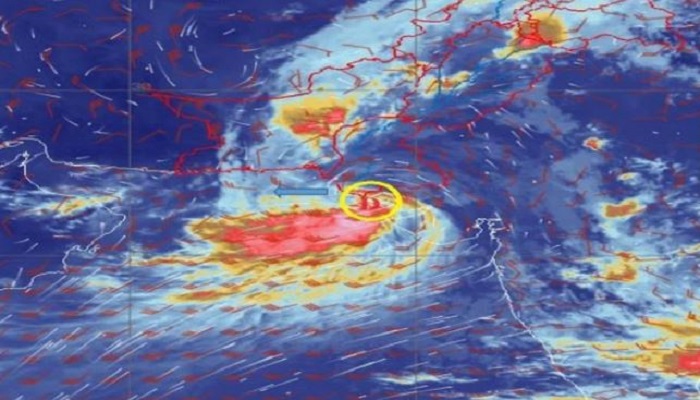KARACHI: As per the fifth tropical cyclone alert issued by the Pakistan Meteorology Department (PMD) on Friday that a low-pressure system, slowly advancing from India’s Rann of Kutch toward the Arabian Sea, is now approximately 120 kilometers southeast of Karachi.
This depression, which is a strong low-pressure system, is expected to continue moving west-southwest along Sindh’s coastal region.
The PMD indicated that this low-pressure system might strengthen into a cyclonic storm later today (Friday) if favorable environmental conditions persist.
PMD Director General Mehar Sahibzada Khan stated during a press conference that the cyclone, named Asna, developed near the Karachi-Gwadar coast and could cause heavy rainfall once it strikes the western coastal areas.
He explained that while cyclones typically move from sea to land, Asna is behaving oppositely. It is expected to intensify into a hurricane, with its effects becoming apparent next week.
Due to this cyclone, the country is experiencing above-normal rainfall, with the upper regions likely to see increased rainfall from September 2 to 4.
Mehar predicted that the weather in southern areas would improve within the next two days. Additionally, the Met Office forecasted heavy rain in Karachi within the next 24 hours, along with strong winds and thunderstorms. On Friday, the city’s temperature ranged between a minimum of 26°C and a maximum of 28°C to 30°C, with winds blowing from the northeast at 22 km/hour.
The Met Office also reported that Sindh regions influenced by the potential cyclonic storm, including Karachi, Tharparkar, Badin, Thatta, Sujawal, Hyderabad, Tando Muhammad Khan, Tando Allah Yar, Matiari, Umerkot, Mirpurkhas, Sanghar, Jamshoro, Dadu, and Shaheed Benazirabad districts, are likely to experience heavy rainfall until August 31.
Heavy downpours are also expected in Hub, Lasbella, Awaran, Kech, and Gwadar districts from August 30 to September 1, with intermittent breaks.
The PMD warned that the heavy rain might lead to waterlogging in low-lying areas along the Sindh-Makran coast and rough sea conditions with gusty winds. Fishermen in Sindh and Balochistan have been advised not to venture into the sea until September 1, and residents are urged to avoid unnecessary travel.
Meanwhile, Karachi experienced continuous rainfall on Thursday, which intensified later in the night. Sarjani Town recorded the highest rainfall at 127.6 millimeters, while DHA Phase II recorded the lowest at 10.7 millimeters. Other recorded rainfalls include:
- Sarjani Town: 127.6mm (highest)
- Gulshan-e-Hadid: 46mm
- Nazimabad: 45.2mm
- Kemari: 42mm
- PAF Faisal Base: 38mm
- Korangi: 36.3mm
- North Karachi: 32.9mm
- University Road: 32.8mm
- Quaidabad: 29.5mm
- Old Airport: 29.4mm
- Gulshan-e-Maymar: 26mm
- PAF Masroor Base: 25.5mm
- Jinnah Terminal: 25.4mm
- Orangi: 18.8mm
- Gadap: 12.1mm
- DHA Phase II: 10.7mm (lowest)



















